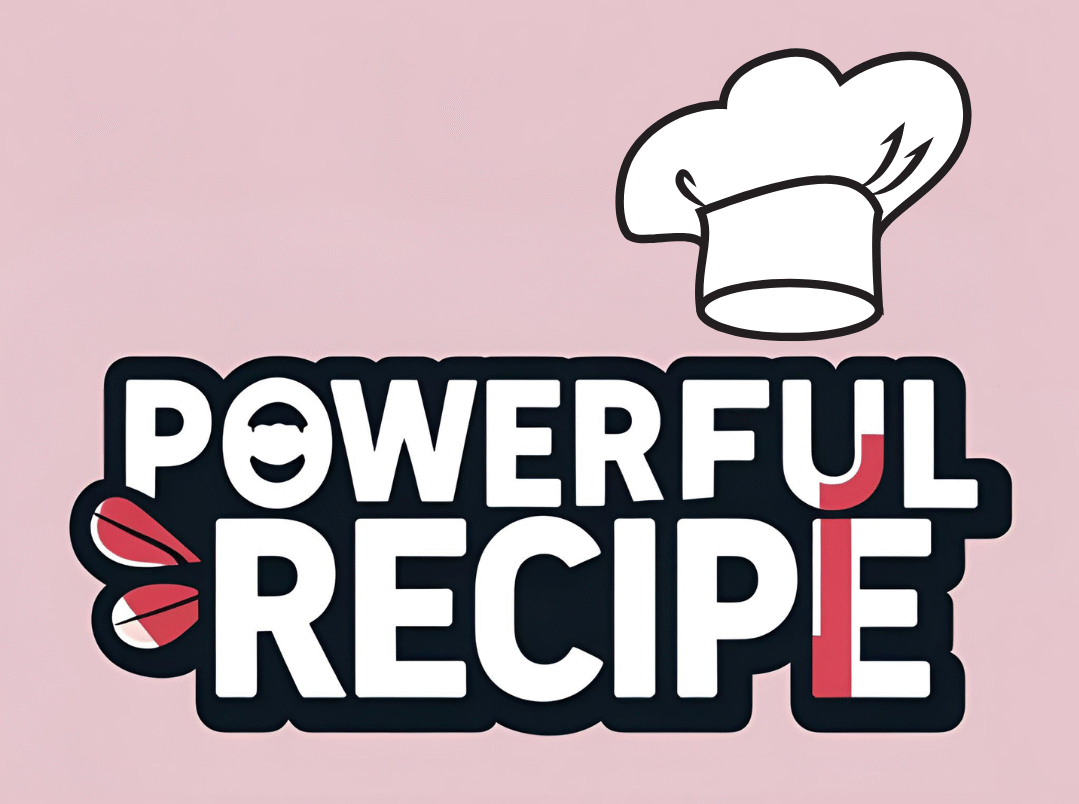Paella Recipe— even the name sounds like music, doesn’t it? This legendary dish from Spain is far more than just a combination of rice, meat, and vegetables. It’s a symbol of togetherness, flavor, and centuries-old tradition. Whether you’re an adventurous home cook or someone seeking to reconnect with Spanish roots, learning how to cook the perfect Paella Recipe opens the door to a deeply rewarding culinary experience.
The word “paella recipe” comes from the Valencian word for “pan,” and while the pan is important, what truly defines paella is its heart — a balance of saffron-scented rice, aromatic spices, and carefully selected proteins. Traditionally cooked over an open flame and served straight from the pan, paella is more than a meal — it’s a celebration.
Across Spain and now the world, this dish has taken on various forms. From the classic Paella Valenciana with rabbit and snails to the seafood-rich Paella de Mariscos, there’s a version of paella for every palate and occasion. In this guide, we’re diving deep into everything you need to know to make the best paella recipe at home — no matter where you are in the world.
We’ll explore its history, uncover essential ingredients, guide you through equipment choices, and provide step-by-step recipes. You’ll learn tips from seasoned Spanish chefs, discover how to avoid the most common mistakes, and even find out how to twist tradition just enough to make it your own. By the time you finish this article, you’ll be fully equipped to serve up a sizzling, golden-crusted paella with confidence.
So, tie on your apron, grab your wooden spoon, and let’s begin the journey to your most delicious paella yet.
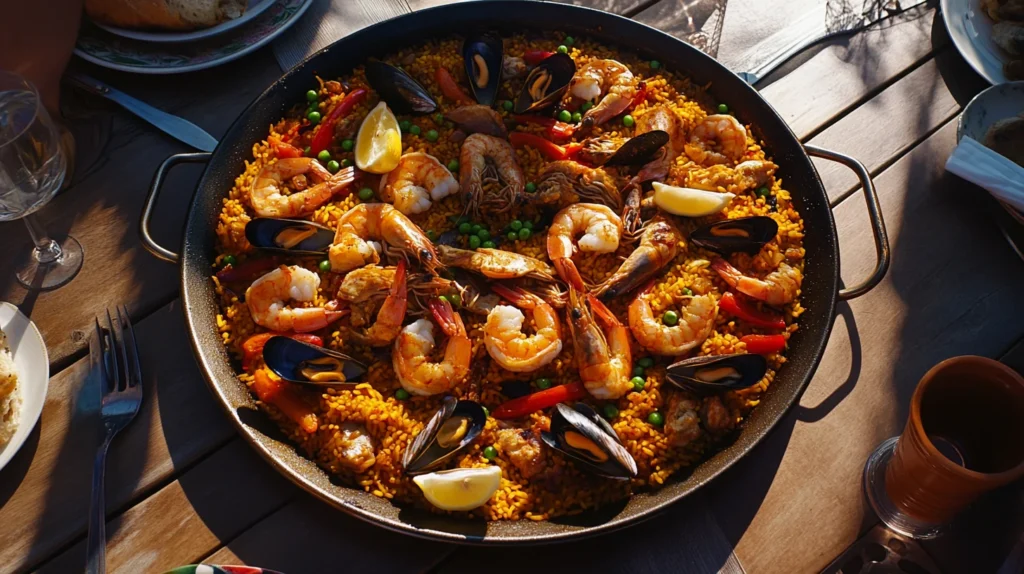
What is Paella Recipe?
The Traditional Roots of Paella Recipe
To truly master the art of any paella recipe, you need to begin at the source. Paella originated in Valencia, a sun-soaked region on the eastern coast of Spain. While some consider it Spain’s national dish, Valencians will proudly argue that paella is distinctly theirs, and they aren’t wrong — it’s where it all began.
Historically, paella was a humble, rural meal cooked by farmers and laborers in the countryside. These early versions were made using whatever ingredients were available — most commonly rabbit, chicken, duck, and sometimes snails, all simmered with short-grain rice, local vegetables, olive oil, water, and of course, saffron, the spice that gives paella its golden glow. It was cooked over an open flame, often fueled by orange tree branches, giving it a subtle smokiness that added depth to the flavor.
The dish’s success lies in its simplicity and its social nature. Paella was traditionally eaten directly from the pan using wooden spoons, a practice still honored today in many Spanish homes. It’s a dish that brings people together, often served during celebrations, family reunions, and community events.
The most sacred rule of the original paella? Never mix seafood and meat — each version stands alone in its identity. That rule has evolved in modern kitchens, but traditionalists still hold it dear.
Different Regional Varieties in Spain
Spain’s geography, rich in coastal towns and inland farmlands, lends itself beautifully to a wide variety of paella recipes. As the dish spread from Valencia across the rest of Spain and eventually the world, different regions added their own local ingredients and flair. Let’s explore a few of the most popular types:
Paella Valenciana – The Original Recipe
This is the OG paella, and purists will insist that if it doesn’t include rabbit, chicken, green beans (judía verde), and butter beans (garrofó), it’s simply not the real deal. Cooked in olive oil with a base of sofrito (a slow-cooked mix of tomato, onion, garlic, and peppers), this version has been passed down for generations in Valencia.
Paella de Mariscos – Seafood Paella
When you think of Spanish paella served on a Mediterranean beach, this is it. Seafood Paella replaces land meats with an array of shellfish — think mussels, clams, shrimp, squid, and langoustines — all layered over a rice base infused with fish stock and saffron. It’s a lighter, ocean-forward dish that shines in coastal regions like Alicante and Barcelona.
Paella Mixta – Mixed Paella
The most popular outside of Spain, especially in restaurants around the world. Paella Mixta blends land and sea — chicken, rabbit, shrimp, and mussels, sometimes even with chorizo (though that’s not traditional). It’s a fusion-friendly version that appeals to broader palates.
Vegetarian and Vegan Paella
Spain may be meat-heavy in tradition, but even paella has adapted. These versions often feature artichokes, bell peppers, green beans, peas, asparagus, and mushrooms. The base remains the same: sofrito, olive oil, and saffron-scented rice. It’s a vibrant, colorful dish perfect for those who want all the richness of paella without the animal products.
Arroz Negro – The Black Rice
Though not technically “paella” by traditional standards, this dish deserves a mention. Popular in Catalonia, arroz negro uses squid ink to dye the rice a striking black. It’s loaded with seafood and often topped with a dollop of alioli (garlic mayonnaise).
What Makes Each Paella Unique?
While the ingredients vary, three elements define every good paella:
- The Rice – Always a short-grain like Bomba or Calasparra.
- The Socarrat – The toasted, crispy rice at the bottom of the pan — considered a delicacy.
- The Technique – Layering flavors without over-stirring, and letting the rice cook undisturbed.
From rustic farm versions to elegant seafood plates, paella is a dish that tells the story of Spanish landscapes and traditions — and it’s ready for your kitchen next.
Essential Ingredients for Authentic Paella Recipe
Core Ingredients You Should Never Skip
No matter which version of the paella recipe you’re preparing, some ingredients are non-negotiable. They form the foundation of the dish’s signature flavor, texture, and color. Skip these, and it might still be a tasty rice dish—but it won’t be paella.
Short-Grain Rice (Bomba or Calasparra)
This is the most important ingredient. Spanish short-grain rice varieties like Bomba or Calasparra are prized for their ability to absorb liquids—up to three times their volume—without getting mushy. These grains remain firm, delivering the ideal paella texture: creamy yet separate.
❗ Tip: Never use long-grain, basmati, or jasmine rice. They cook too fast and won’t give you the beloved socarrat — the crispy golden crust at the bottom of the pan.
Saffron
Known as “red gold,” saffron gives paella its distinctive golden hue and floral aroma. Real saffron is expensive but essential. It’s made from the stigmas of the crocus flower and should be soaked in warm water or stock before being added to the rice.
❗ Beware of imitations: Yellow food coloring or turmeric are sometimes used as substitutes, but they won’t provide the complex flavor or aroma of real saffron.
Olive Oil
Quality extra virgin olive oil is the base of every good sofrito — the flavor foundation of Spanish cooking. It adds richness and helps marry the meat or seafood with the vegetables and rice.
Sofrito
A slow-cooked blend of onions, tomatoes, garlic, and sometimes red bell pepper, sofrito is cooked down in olive oil until it becomes a deeply caramelized, flavorful paste. This mix forms the aromatic backbone of the dish.
Stock or Broth
Whether it’s chicken, seafood, or vegetable stock, a good broth adds depth. Homemade is ideal, but store-bought low-sodium versions can work in a pinch. The broth should be infused with saffron for an authentic touch.
Proteins (Depending on the Style)
- Paella Valenciana: Rabbit, chicken, and sometimes snails.
- Seafood Paella: Shrimp, mussels, clams, squid, langoustines.
- Mixed Paella: A blend of chicken, seafood, and sometimes chorizo.
- Vegan/Vegetarian Paella: Artichokes, mushrooms, peas, asparagus.
No matter the variety, the protein should complement, not overwhelm, the rice.
Vegetables
Most traditional paellas include green beans, bell peppers, and tomatoes. Regional varieties may also include butter beans (garrofó), artichokes, or even zucchini.
Ingredient Substitutions for Modern Kitchens
Let’s be honest—while we’d all love access to fresh saffron and Bomba rice at the local market, that’s not always realistic. If you’re cooking paella outside of Spain, here’s how to adapt without compromising the integrity of your dish.
Rice Alternatives
If Bomba or Calasparra rice isn’t available, use Arborio rice (commonly used for risotto). It absorbs flavor well and maintains a creamy, firm bite. It’s not a perfect match but a strong runner-up.
Avoid parboiled or quick-cook rice, which will fall apart during cooking.
Saffron Substitutes
When saffron is too expensive or unavailable, a blend of turmeric and paprika can offer a similar color with a warm flavor. It won’t be the same, but it keeps the dish vibrant and spiced.
To imitate saffron’s depth, a small pinch of ground annatto or smoked paprika adds richness too.
Stock Hacks
Homemade stock is always best, but a well-seasoned store-bought broth can work wonders. Enhance it by simmering with shrimp shells, chicken bones, saffron threads, and bay leaves for 20–30 minutes before using.
You can even use bouillon cubes or stock concentrates in a pinch—just adjust the salt to avoid overseasoning.
Proteins on a Budget
Can’t find rabbit or langoustines? No worries. Bone-in chicken thighs, frozen shrimp, or mixed seafood packs can be excellent alternatives. Firm white fish like cod or monkfish also hold up well in seafood paella.
For vegetarians, go with a medley of mushrooms, chickpeas, and eggplant to create hearty flavors.
Olive Oil Alternatives
While extra virgin olive oil is the gold standard, you can use light olive oil or a neutral oil like grapeseed or avocado oil in a pinch. Avoid butter or coconut oil—they’ll throw off the flavor profile.
From pure traditionalists to modern-day home chefs, knowing your way around these paella ingredients makes all the difference. In the next section, we’ll walk through the actual recipe — step-by-step — so you can bring these components together in perfect harmony.
Don’t have time for paella today? Check out these easy lunch recipes when you’re not cooking paella.
How to Choose the Right Paella Pan
Importance of the Correct Pan
When it comes to executing the perfect paella recipe, the pan you use matters just as much as the ingredients. A traditional paellera (paella pan) is wide, shallow, and typically made of carbon steel. Its unique shape allows the rice to cook in a thin, even layer — essential for developing the golden socarrat, the crispy crust at the bottom that true paella lovers treasure.
Unlike deep pans or pots, the paellera is designed to maximize surface area. This is crucial because the goal is not to stir the rice like a risotto but to let it simmer and absorb all the liquid undisturbed.
Tips for Size and Material
Here’s how to choose the right paella recipe pan for your kitchen:
Sizing Guide
- 2–3 people: 10–12 inch (26–30 cm) pan
- 4–6 people: 13–15 inch (34–38 cm) pan
- 8+ people: 16+ inch (40+ cm) pan or larger
It’s always better to go slightly bigger than you think—you don’t want to overcrowd the rice, as it will steam rather than toast.
Materials
- Carbon Steel: The most traditional and responsive to heat. It builds flavor and caramelization well but requires maintenance to avoid rust.
- Enameled Steel: Easier to clean, rust-resistant, but slightly less responsive to heat.
- Stainless Steel: Durable and low-maintenance, but may not heat as evenly.
- Nonstick: Convenient for beginners, but you won’t get an authentic socarrat.
If you don’t have a paella pan, a large stainless steel or cast-iron skillet can work in a pinch—as long as it’s wide and shallow enough.
Step-by-Step Traditional Paella Recipe
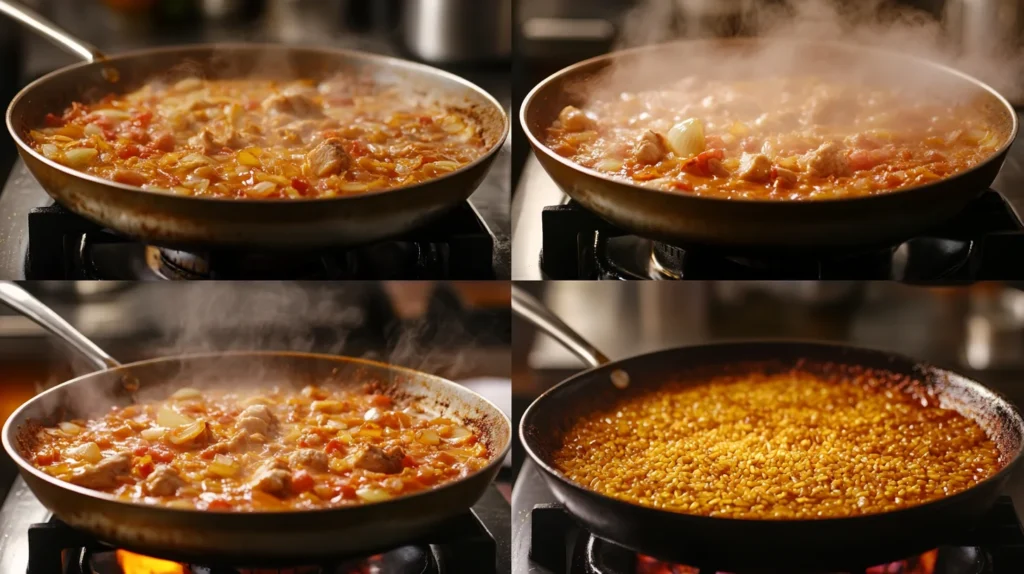
Ingredients (Serves 4)
- 2 tbsp extra virgin olive oil
- ½ lb (225g) chicken thighs, chopped
- ½ lb (225g) rabbit or additional chicken
- 1 cup (200g) Bomba or Arborio rice
- 2 ripe tomatoes, grated
- 1 small onion, finely chopped
- 1 cup green beans (judía verde), trimmed
- ½ cup butter beans (garrofó) or lima beans
- 4 cups chicken broth (warm)
- 1 pinch saffron threads (soaked in warm water)
- 1 tsp smoked paprika
- Salt to taste
- Lemon wedges for serving
Step 1 – Prepare the Sofrito
In your paella recipe pan, heat the olive oil over medium heat. Add chopped onions and cook for about 5 minutes until soft and translucent. Stir in the grated tomatoes and paprika. Let it reduce into a thick, rich base — this is your sofrito, packed with bold flavor.
Step 2 – Brown the Meat
Add the chicken and rabbit pieces into the pan, seasoning with salt. Brown on all sides until nicely golden. This step builds foundational flavor and adds beautiful color to the meat.
Step 3 – Add the Vegetables
Toss in the green beans and butter beans. Cook for 5–6 minutes to let them absorb some of the meaty flavors from the pan.
Step 4 – Stir in the Rice
Add the rice evenly across the pan — don’t pile it! Stir it gently to coat in the oil and sofrito. This ensures every grain will soak up flavor.
Step 5 – Pour in the Stock
Slowly pour in the warm broth and saffron-infused water. At this point, do not stir again. Spread the ingredients evenly, bring to a boil, then lower to a gentle simmer.
Let it cook for about 18–20 minutes, uncovered, until most of the liquid is absorbed and the rice is tender but still firm.
Step 6 – Form the Socarrat
During the last few minutes, increase the heat for a short burst (about 1–2 minutes) to create the socarrat—a lightly toasted layer of rice at the bottom. You’ll know it’s working when you hear a gentle crackling sound. Be careful not to burn it!
Step 7 – Rest and Serve
Remove the pan from the heat and cover with a clean kitchen towel or aluminum foil. Let it rest for 5–10 minutes to allow the rice to finish steaming. Serve with lemon wedges for brightness and flair.
Congratulations — you’ve just cooked a truly authentic paella recipe that would make a Valencian grandmother proud 🇪🇸!
Common Mistakes to Avoid When Cooking Paella Recipe
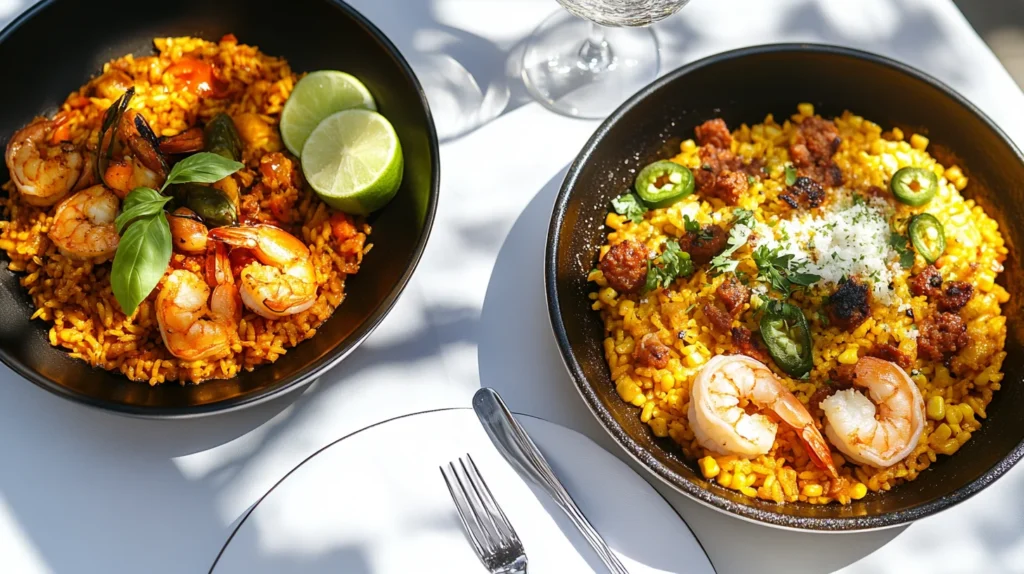
Even experienced cooks can misstep when attempting a paella recipe, especially if they’re new to the nuances of Spanish cuisine. Avoiding these common mistakes is key to nailing that perfect bite every time.
Over-Stirring the Rice
Mistake: Treating paella like risotto.
Fix: Stir only once — when you add the rice. After that, let it be! Paella is meant to cook undisturbed, so the rice absorbs the broth evenly and forms that coveted socarrat at the bottom. Stirring will turn the texture creamy and mushy — not what you want.
Using the Wrong Type of Rice
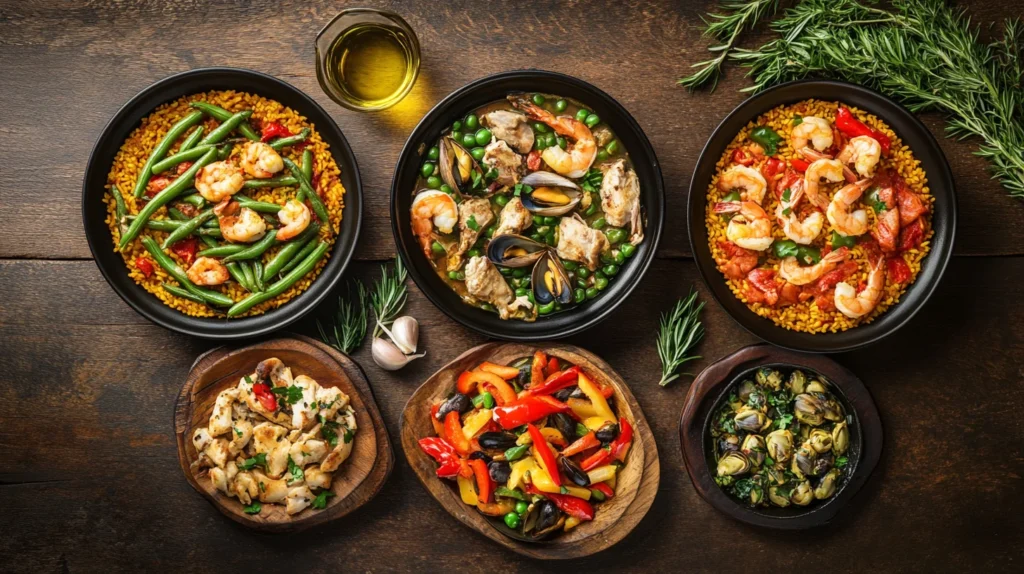
Mistake: Reaching for long-grain or instant rice.
Fix: Use short-grain varieties like Bomba or Calasparra. These can absorb more liquid without breaking down. If you must substitute, opt for Arborio, but adjust cooking time accordingly.
Overloading the Pan
Mistake: Too many ingredients or too much rice.
Fix: Keep the rice layer thin and avoid crowding the pan. This ensures even cooking and allows the broth to evaporate properly. Overcrowding causes uneven texture and soggy results.
Skipping the Resting Time
Mistake: Serving straight from the heat.
Fix: Always rest the paella for at least 5–10 minutes before serving. This step allows the rice to finish cooking and firm up, locking in flavor and moisture.
Not Letting the Socarrat Form
Mistake: Turning off the heat too early.
Fix: During the final minutes, increase the heat briefly to create that caramelized crust. Listen for the gentle crackling at the bottom of the pan — it’s music to a paella lover’s ears.
Tips from Spanish Chefs
Spanish chefs, especially those from Valencia, treat paella like an art form — with equal parts passion and precision. Here are some of their tried-and-true secrets:
Use a Wood Fire If You Can
While modern stoves work fine, traditional paella is cooked over an open flame, ideally using orange or pine wood. This imparts a subtle smokiness and helps with even heat distribution. If you can, try using a grill or paella burner outdoors.
Infuse the Broth with Flavor
Chef José Andrés recommends simmering the stock with roasted vegetables, shrimp shells, and saffron before adding it to the rice. This gives your broth incredible depth, making every bite of rice burst with umami.
Don’t Be Afraid of Simplicity
Many top chefs argue that the best paellas aren’t overloaded with ingredients. Focus on quality over quantity. A few fresh, seasonal ingredients cooked well will always beat a paella with too many flavors competing on the plate.
Embrace the Socarrat
The crispy bottom isn’t a cooking accident — it’s intentional. Let the rice cook until you hear a faint crackle, then remove from heat. This crunchy layer is often the first part people fight over at the table.
Modern Twists on Classic Paella Recipe
As paella has gained popularity worldwide, chefs and home cooks alike have started to experiment — and the results can be surprisingly delicious.
Fusion Paella Ideas
- Thai-Inspired Paella: Add coconut milk, lemongrass, and shrimp for a Southeast Asian spin.
- Mexican Paella: Spice it up with chorizo, chipotle, corn, and avocado.
- Italian Style: Think of paella with parmesan shavings, Italian sausage, and sun-dried tomatoes.
These creative variations may veer from the original, but they keep the paella spirit alive — celebrating local ingredients and bold flavors.
Using Modern Kitchen Appliances
Yes, you can make a decent paella using today’s gadgets:
Instant Pot or Pressure Cooker
Use the sauté setting for sofrito, add your rice and broth, then cook under pressure for 6 minutes with a natural release. It won’t give you a socarrat, but it’s great for weeknights.
Oven-Baked Paella
After stovetop prep, transfer your paella pan to the oven to finish cooking. This allows even heating and is perfect if you’re entertaining guests and don’t want to babysit the stove.
Air Fryer Hack (Small Portions)
Believe it or not, you can cook mini paella servings in an air fryer using individual metal trays. The trick is to keep the rice layer thin and check regularly to avoid drying it out.
Whether you’re a stickler for tradition or a culinary innovator, there’s always room to personalize your paella recipe. The key is to respect the rice, honor the flavor, and gather around the pan with people you love.
Paella Recipe for Special Occasions
Paella Recipe is more than food — it’s a celebration in a pan. Across Spain and in many parts of the world, it’s a go-to dish for festivals, holidays, and family gatherings. And why not? It’s festive, colorful, shareable, and adaptable to large groups.
Serving Paella Recipe at Parties or Events
When you’re cooking for a crowd, paella is perfect because it’s a one-pan meal that impresses visually and satisfies every appetite. You can scale the recipe up using a larger paella pan or even cook outdoors with a gas ring burner or open fire.
Tips for hosting a paella recipe party:
- Cook outside if possible — it adds a rustic vibe.
- Set up a few small tapas (olives, cheese, croquetas) while guests wait.
- Time it right — paella recipe is best served fresh from the pan, not reheated.
Wine Pairings and Side Dishes
For seafood paella, pair it with a crisp Albariño or Verdejo. For meat-based paella, a Garnacha or light Rioja red works beautifully.
As for sides? Keep it simple:
- Light green salad with olive oil and lemon
- Grilled vegetables
- Rustic bread to soak up the flavors
Health and Nutrition Facts
Paella is surprisingly balanced, especially when made with fresh ingredients and olive oil. Here’s a rough breakdown for one serving (1.5 cups):
| Nutrient | Approx. Amount |
|---|---|
| Calories | 350–450 kcal |
| Protein | 25–30g |
| Carbohydrates | 35–40g |
| Fat | 12–18g |
| Fiber | 3–6g |
| Sodium | Varies (use low-sodium stock!) |
Making It Healthier
- Use brown rice or quinoa for more fiber (adjust cooking time).
- Go heavy on vegetables, light on red meats.
- Steam or grill seafood instead of frying.
- Skip or reduce salt by using herbs and spices for flavor.
Storing and Reheating Leftover Paella Recipe
How Long Does Paella Recipe Last?
Store leftover paella recipe in an airtight container in the refrigerator for up to 3 days. Avoid letting it sit at room temperature for too long, as seafood and rice can spoil quickly.
Best Reheating Methods
Microwave
- Add a splash of broth or water
- Place a damp paper towel over the dish to help retain moisture during reheating.
- Heat in 1-minute bursts, stirring gently
Stove
- Heat in a nonstick skillet with a few drops of olive oil
- Add 2–3 tbsp of water or stock
- Cover and steam for a few minutes
Avoid reheating in the oven — it often dries the rice out completely.
Can You Freeze Paella Recipe?
Yes, but it’s not ideal. Freezing can change the rice texture. If you must:
- Freeze in small, airtight portions
- Use within 1 month
- Reheat slowly to preserve flavor
Sides:
- Mixed green salad
- Grilled vegetables
- Rustic bread
- Light vegetable starters to complement your paella
Frequently Asked Questions
What is the secret to a good paella?
The secret to a good paella lies in layering flavor and respecting the process. It starts with a rich sofrito base (tomatoes, onion, garlic) sautéed slowly in olive oil, followed by using the right rice — preferably Bomba or Calasparra — and a well-infused broth. Most importantly, avoid stirring after adding the liquid to allow the rice to form the socarrat, the crispy bottom layer that defines an authentic paella. Timing, heat control, and quality ingredients are essential to unlocking the full depth of any paella recipe.
What is the secret ingredient in paella?
The secret ingredient in paella is undoubtedly saffron. These tiny red threads impart not just the iconic golden color but also a delicate floral aroma and earthy flavor that’s impossible to replicate. Saffron elevates the entire dish from good to unforgettable. Another lesser-known tip from chefs is to simmer shrimp shells or chicken bones in the stock beforehand — it deepens the umami and adds a homemade touch to your paella recipe.
What are the ingredients of paella?
A traditional paella recipe includes the following essential ingredients:
Short-grain rice (Bomba or Calasparra)
Saffron threads (for color and aroma)
Olive oil
Sofrito (grated tomato, onion, garlic, paprika)
Stock or broth (chicken, seafood, or vegetable)
Meats or seafood (chicken, rabbit, mussels, shrimp, clams, etc.)
Vegetables (green beans, butter beans, red peppers, artichokes)
Salt and spices (especially smoked paprika)
Variations may include seafood, meat, or vegetables depending on regional or personal preferences.
What is a traditional paella made of?
A traditional paella Valenciana — the original version of the dish — is made with rabbit, chicken, green beans (judía verde), and large white beans (garrofó). It’s cooked with short-grain rice, saffron, and olive oil over an open flame. The base is a slow-cooked sofrito, and the dish is seasoned with paprika and rosemary, depending on the region. The beauty of traditional paella is in its simplicity, and its roots as a farmer’s dish made with what was available in the field. This version doesn’t include seafood or chorizo, which are more common in modern interpretations.
Conclusion
There you have it — a complete, detailed, and soul-satisfying guide to crafting the perfect paella recipe in your own kitchen. Whether you’re sticking to the time-honored Valencian version or putting your own spin on it with modern ingredients, the essence of paella lies in gathering around the pan, sharing a flavorful meal, and creating memories.
Now that you’re armed with the history, the technique, the right tools, and even tips from the pros, it’s time to fire up the stove (or grill), invite your favorite people over, and make some magic happen — one grain of saffron-scented rice at a time.
Buen provecho! 🇪🇸
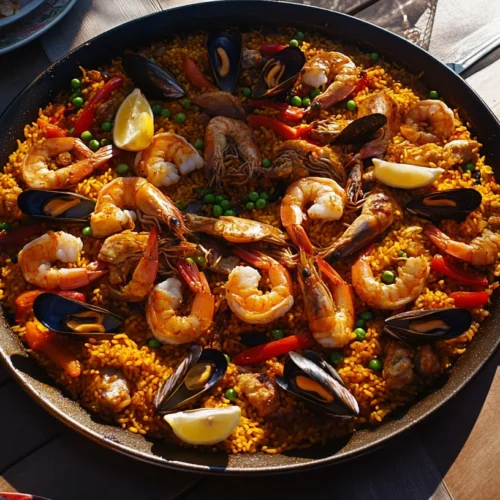
Authentic Traditional Paella Recipe (Valencian Style)
Equipment
- Large paella pan (12–15 inches for 4 servings)
- Gas burner or stovetop
- Wooden spoon or spatula
- Sharp knife and cutting board
- Small saucepan (for warming stock)
- Grater (for tomatoes)
- Measuring cups and spoons
Ingredients
- Protein & Vegetables:
- ½ lb 225g chicken thighs, chopped
- ½ lb 225g rabbit (or extra chicken), chopped
- 1 cup green beans judía verde, trimmed
- ½ cup butter beans or lima beans
- 2 ripe tomatoes grated
- 1 small onion finely chopped
- 3 garlic cloves minced
- Grains & Seasoning:
- 1 cup 200g Bomba rice (or Calasparra or Arborio)
- 4 cups chicken broth warmed
- 1 pinch saffron threads soaked in 2 tbsp warm water
- 1 tsp smoked paprika
- Salt to taste
- 2 tbsp extra virgin olive oil
- Lemon wedges for garnish
Instructions
- Heat Oil & Make Sofrito:
- Heat olive oil in the paella pan over medium heat. Add onions and cook until soft. Stir in grated tomatoes, garlic, and paprika. Let simmer until thickened (5–7 minutes).
- Brown the Meat:
- Add chicken and rabbit. Season with salt and brown on all sides, about 8–10 minutes.
- Add Vegetables:
- Toss in green beans and butter beans. Stir and cook for another 5 minutes.
- Add Rice:
- Sprinkle the rice evenly across the pan. Stir gently to coat in the sofrito mixture.
- Pour in Broth:
- Add the warm broth and saffron water evenly. Don’t stir again. Bring to a boil, then reduce heat to low and simmer for 18–20 minutes, uncovered.
- Form Socarrat (Crispy Base):
- During the final 2–3 minutes, increase heat to high to create the crispy bottom layer (listen for a light crackling sound). Don’t burn it.
- Rest & Serve:
- Remove from heat, cover with a kitchen towel, and rest for 5–10 minutes. Garnish with lemon wedges. Serve warm, directly from the pan.
